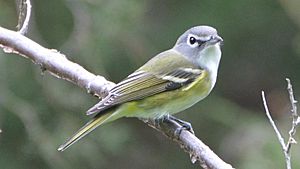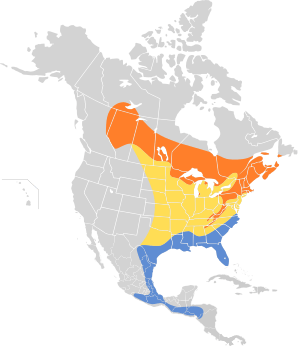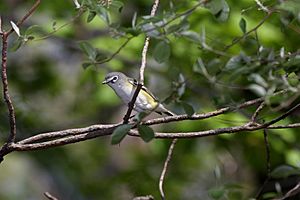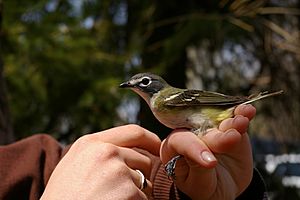Blue-headed vireo facts for kids
Quick facts for kids Blue-headed vireo |
|
|---|---|
 |
|
| Conservation status | |
| Scientific classification | |
| Genus: |
Vireo
|
| Species: |
solitarius
|
 |
|
The blue-headed vireo (Vireo solitarius) is a small song bird that travels between North and Central America. It is a type of Neotropical bird, meaning it lives in the warmer parts of the Americas.
This bird gets its name from its blue-grey head. It also has bright yellow bars on its wings. Both male and female blue-headed vireos look very similar in color and size. Young birds also look much like the adults.
Since the 1970s, the number of blue-headed vireos has been growing. Because of this, they were listed as a "Least Concern" species in 2004, meaning they are not currently at risk.
Contents
What Does the Blue-headed Vireo Look Like?
The blue-headed vireo keeps its colors all year, even during breeding season. It has an olive-green back and a deep blue-grey head, which is how it got its name. You can also spot two bright yellow bars on its wings. Young blue-headed vireos look very similar to the adults.
This bird looks a bit like its relative, the Cassin's vireo (Vireo cassinii). However, the Cassin's vireo has lighter yellow patches, a thinner beak, and a brownish-grey head. Male and female blue-headed vireos are almost the same in color and size.
Blue-headed vireos are fairly small birds. They are usually about 126–148 mm (5.0–5.8 in) long. Their wings can spread about 200–240 mm (7.9–9.4 in) wide, and they typically weigh 13–19 g (0.46–0.67 oz).
There are two slightly different types, or subspecies, of the blue-headed vireo. One type, V.s. alticola, is a bit larger and has a darker back. The other type, V.s. solitarius, is slightly smaller.
In the wild, a blue-headed vireo usually lives for about 7 years and 5 months.
Blue-headed Vireo Family Tree
The blue-headed vireo belongs to a group of birds called Vireos. These are small perching birds that often have dull green colors and simple songs. Vireos are usually identified by marks around their eyes or on their wings. Males and females in this group look alike.
For a while, in the 1950s, the blue-headed vireo was grouped with two other vireos (the plumbeous vireo and Cassin's vireo) into one species called the "Solitary Vireo." But in 1997, new scientific studies showed that they were actually three separate species. So, the blue-headed vireo became its own species again.
There are two recognized subspecies of the blue-headed vireo:
- Vireo solitarius solitarius: This is the slightly smaller type. It breeds across Canada down to Pennsylvania and New Jersey. In winter, it flies south to Mexico.
- Vireo solitarius alticola: This type is a bit larger. It breeds mainly in the Appalachian Mountains down to northern Georgia. It travels a shorter distance for winter, staying in the Gulf States.
Where Do Blue-headed Vireos Live?
Blue-headed vireos live in North America. They have a very large breeding area that covers much of Canada and the northern United States.
The V.s. solitarius subspecies breeds from British Columbia across Canada to Quebec and down to Pennsylvania. The V.s. alticola subspecies breeds mainly in the Appalachian Mountains.
After breeding season, blue-headed vireos fly south for the winter. V.s. solitarius travels further, spending winter in Mexico and Central America. V.s. alticola has a shorter trip, wintering from southeastern Virginia to Texas.
These birds like to breed in cool forests that have a mix of evergreen trees (like spruce, fir, and pine) and deciduous trees (like alder, willow, and maple). In winter, they live in mixed forests, coastal swamps, and thick bushes.
Even during breeding season, these birds are not found in huge numbers in one place. They are usually spread out. During migration, blue-headed vireos often fly with different types of sparrows, but rarely with other blue-headed vireos.
Forest Changes
When blue-headed vireos arrive at their breeding spots in mid-April, many deciduous trees haven't grown their leaves yet. So, they often build their nests in evergreen trees like hemlocks. However, an invasive insect called the Hemlock woolly adelgid has been killing many hemlock trees in the eastern USA. This means fewer nesting choices for the vireos until other trees get their leaves.
How Blue-headed Vireos Behave
Their Songs and Calls
The main song of the male blue-headed vireo is slow and simple. It can sometimes be confused with the faster song of the red-eyed vireo. Males sing mostly during the breeding season to attract females.
Both male and female vireos use different calls to defend their nests, compete with other birds, and talk to each other while they are looking for food. When a mated pair is searching for food, they often make high-pitched chirping calls to stay in touch.
What They Eat
Blue-headed vireos mostly eat insects, but they also enjoy berries and fruit. They have short, strong beaks that help them eat insects with hard shells, like beetles.
They usually look for food in the middle parts of trees. A vireo will hop from branch to branch or fly to a nearby tree to catch its prey. Their diet often includes caterpillars, butterflies, moths, stink bugs, bees, ants, flies, dragonflies, grasshoppers, crickets, spiders, and sometimes even snails.
They eat fruit more often during migration and in winter, especially in warmer places where fruit is easy to find or when there aren't many insects around. This wide variety of food shows they are "opportunistic feeders," meaning they can adapt their diet based on what food is available.
How They Raise Their Young
When male vireos arrive at the breeding grounds in mid-April, they claim large areas of land. Females choose a male based on how well he can defend his territory. Males sing to attract females. If two males are trying to attract the same female, they might fight over the territory.
Once a female chooses a mate, the male will build a small "courtship nest" to show off his nest-building skills. This nest is not used for eggs. About two weeks later, the male and female work together to build a real breeding nest. These nests are usually built in the forks of branches in evergreen or deciduous trees, using twigs and leaves. They do not reuse nests from previous years.
A female will lay 3 to 5 eggs, usually one egg per day. The eggs are creamy white with brown or black spots. They are incubated (kept warm) for about 14 days. When the chicks hatch, they are very helpless and have almost no feathers. Their eyes open around day 5 or 6. They will leave the nest after about 14 days, making the total chick-rearing period about 28 days.
After leaving the nest, the young birds are still fed by their parents for about a month. The parents then split the young birds and separate. If a nest is destroyed or the eggs don't hatch, the pair might try to build a new nest, especially if it happens early in the season.
Blue-headed vireo males are very involved in raising their young. They help their mates by sitting on the eggs during the day, building the nest, and feeding the chicks. This is a bit unusual compared to some other related bird species. Scientists think this strong parental care might be linked to their hormone levels, like having lower testosterone and higher prolactin, which encourage caring behaviors.
Who Hunts Them?
Blue-headed vireos have a low success rate for their nests; only about 10–30% of chicks survive. Common predators that eat their eggs and chicks include blue jays, crows, and squirrels.
If a blue jay attacks a nest, both parents will work together to scare it away. One parent will swoop at the jay while calling the other, who then makes a second attack. Blue-headed vireos have also been known to nest near birds of prey (like hawks or owls) that don't hunt vireos. It's thought they do this for protection from squirrels, which the raptors do hunt.
The biggest threat to blue-headed vireo nests is often the parasitic brown-headed cowbird (Molothrus ater). Cowbirds lay their large eggs in vireo nests. The vireo parents then feed the bigger cowbird chick, which often causes their own small vireo chicks to starve.
See also
 In Spanish: Vireo solitario para niños
In Spanish: Vireo solitario para niños




